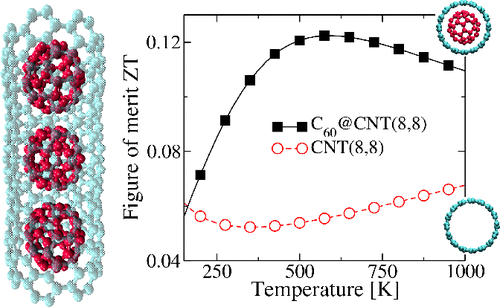Pristine nanotubes have, however, high electrical and thermal conductivities so that further nanoscale engineering is required to exploit them as TE materials. We investigate electron and phonon transport in CNT peapods to elucidate their potential advantage over pristine CNTs as basic TE elements. We show that the electron and phonon transport properties are sensitively modified by C60 encapsulation, when the CNT-C60 intermolecular interaction is strong enough to produce a periodic buckling of the CNT walls. Moreover, the phonon transmission is strongly suppressed at low and high frequencies, leading to a reduction of the phonon contribution to the overall thermal conductance. A similar effect has also been observed in the recently proposed phononic metamaterials. We obtain in general a larger TE figure of merit over a broad temperature range for the CNT peapod when compared with the pristine CNT, achieving an increase by a factor of 2.2 at 575 K. Our findings show an alternative route for the enhancement of the TE performance of CNT-based devices.

Pristine nanotubes have, however, high electrical and thermal conductivities so that further nanoscale engineering is required to exploit them as TE materials. We investigate electron and phonon transport in CNT peapods to elucidate their potential advantage over pristine CNTs as basic TE elements. We show that the electron and phonon transport properties are sensitively modified by C60 encapsulation, when the CNT-C60 intermolecular interaction is strong enough to produce a periodic buckling of the CNT walls. Moreover, the phonon transmission is strongly suppressed at low and high frequencies, leading to a reduction of the phonon contribution to the overall thermal conductance. A similar effect has also been observed in the recently proposed phononic metamaterials. We obtain in general a larger TE figure of merit over a broad temperature range for the CNT peapod when compared with the pristine CNT, achieving an increase by a factor of 2.2 at 575 K. Our findings show an alternative route for the enhancement of the TE performance of CNT-based devices.
